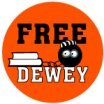Open Shelves Classification Update: Looking for Data from Public Libraries

The Build the Open Shelves Classification group continues to work on the top level classification categories. The word is out and people are excited about the direction we're headed! But we need your help if we want to continue to build this together. We are gathering information in two ways:
1) Group members are searching their public library catalogs by the Dewey numbers associated with our draft list of top level categories and reporting their findings here. This is giving us a good sense of which categories have the biggest representation in public library collections. So far we have good data from large urban public libraries, but we would like more diverse library data. Here is a sample of what we have seen so far:

Please continue to add to the online spreadsheet (you will need a Google account to view or edit) for the next two weeks.
2) As you can see from the chart, the books that are represented by our current top level categories only represent a fraction of their total library collection. We need public librarian volunteers to evaluate what subjects get used the most in their library. You can run a report in your ILS (integrated library system) on subject heading circulation statistics. If you don't know how, ask your systems or technical services librarian. Be anonymous, we do not need to know WHO just WHAT. Thanks to all who have already begun to do this. You can post your results here.
Once we have this information, we can then evaluate if the working list of top level categories needs to be edited.
In other news, graduate students studying Information and Library Science at the Pratt Institute in New York are working on various cataloging projects involving Open Shelves Classification, such as concept mapping OSC to LibraryThing tags. We look forward to sharing their results here on the blog in a few weeks.
Finally, many libraries around the country are trying to create new, usable, efficient alternatives to Dewey. The Frankfort Public Library District is going Dewey free (with stickers to boot, see image above) using a modified version of BISAC. What do you think? As a collective, I think we can improve upon this (also, let us know what you think about this).
Labels: OSC
3 Comments:
Wow. This is great. I haven't really followed progress since it moved onto Google Docs. Apparently there's been a lot.
Has anyone talked to the Frankfort guys?
Can you explain "As you can see from the chart, the books that are represented by our current top level categories only represent a fraction of their total library collection"? I'm unclear on how the chart shows that. I think I'm being thick...
You are right, it is not obvious from the chart. The amount of books for each category is normalized to the total size of its library's entire collection. You can see the percentage for each category is not very high. It is clearer if you look at the raw numbers where it shows that the books in these categories only represent about 15% of each library's entire holdings. That percentage is probably depressed because holdings size includes items other than books. In any case, we would like to see public library circulation data to see if there are any major subject areas we have over looked.
And, yes, we have been in contact with the librarians overseeing the Free Dewey project at Frankfort. They have been very helpful so far!
In addition, the library students are working on really interesting projects. They've started to apply top level categories to librarything collections and are creating concept maps of tags and OSC headings. Curious to see the results in a few weeks!
Post a Comment
<< Home